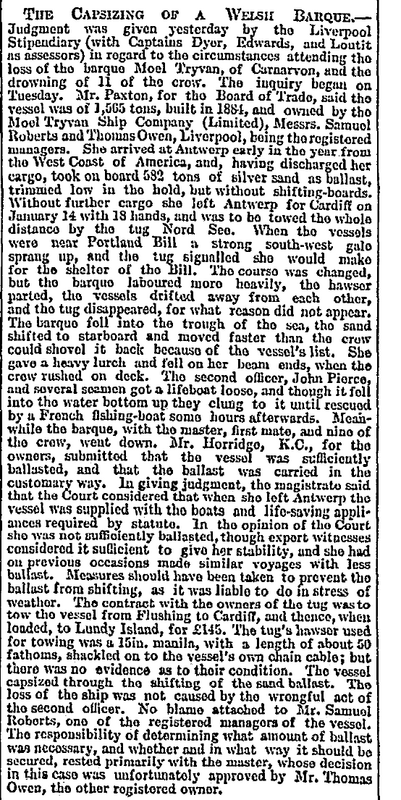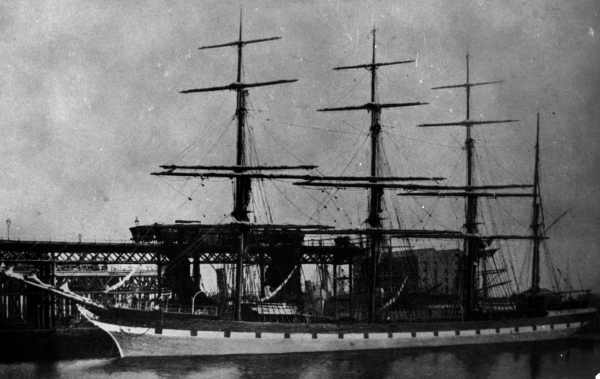
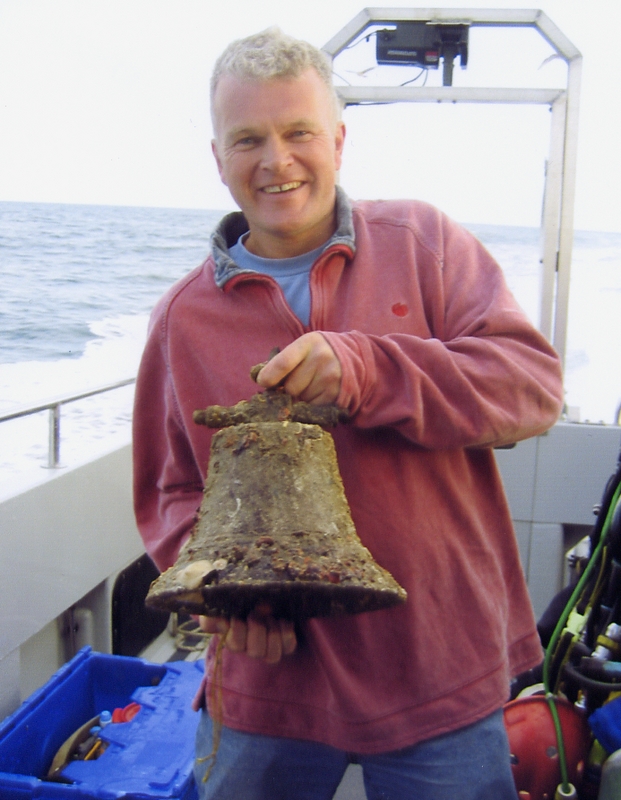
The identity of their wreck eluded us for years until the bell was recovered
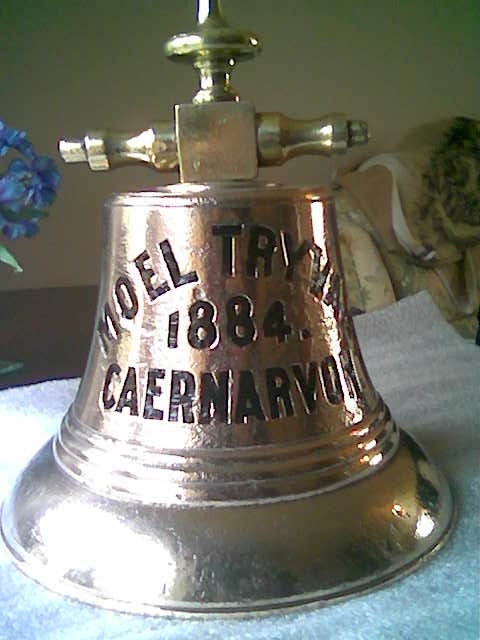
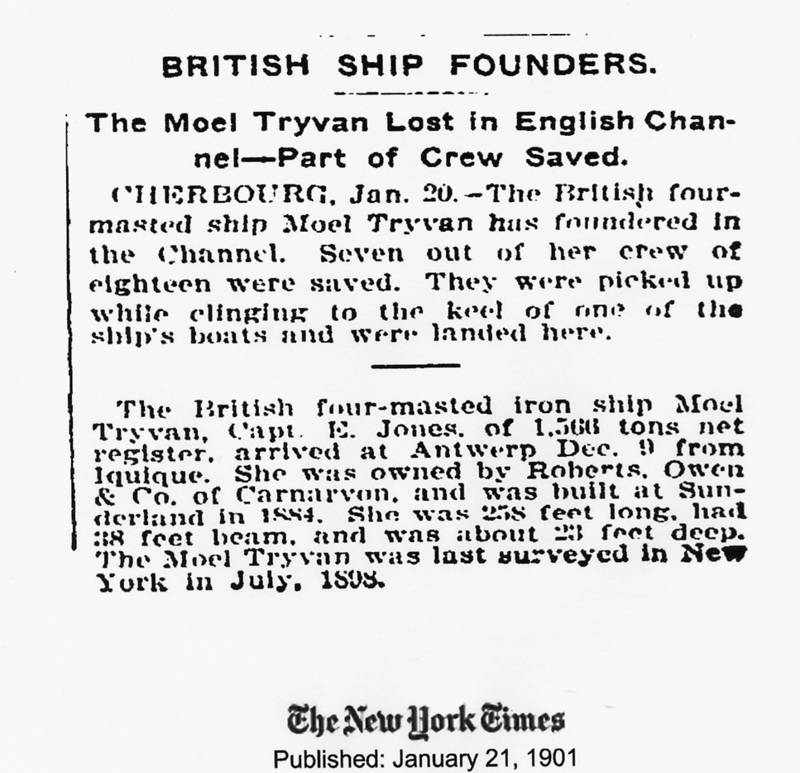
BRITISH SHIP FOUNDERS.
The Moe! Tryvan Lost in English Channel – Part of Crew Saved.
CHERBOURG, Jan. 20. The British four-masted ship Moel Tryvan has foundered in the Channel. Seven out of her crew of eighteen were saved. They were picked up while clinging to the keel of one of the ship’s boats and were landed here.
The British four-masted iron ship Moel Tryvan, Capt. 2. Jones. of 1566 tons net register, arrived at Antwerp Dec. 9 from Iquique. She was owned by Roberts, Owen & Co. of Carnarvon, and was built at Sunderland in 1884, She was 258 feet long, had 38 feet beam, and was about 23 feet deep. The Moel Tryvan was last surveyed in New York in July, 1808.
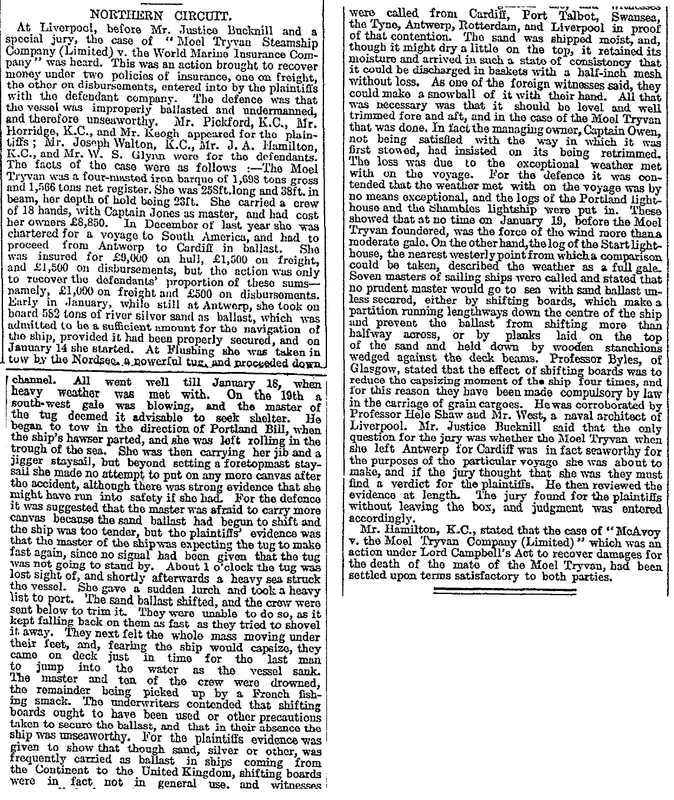
NORTHERN CIRCUIT.
At Liverpool, before Mr. Justice Bucknill and a special jury, the case of Moel Tryvan Steamship Company (Limited) v. the World Marine Insurance Company was heard. “This was an action brought to recover money under two policies of insurance, one on freight, the other on disbursements, entered into by the plaintiffs with the defendant company. ‘The defence was that the vessel was improperly ballasted and undermanned, and therefore unseaworthy, Mr, Pickford, K.C., Mr. Horridge. K.C., and Mr. Keogh appeared for the plaintiffs; Mr. Joseph Walton, K.C. Mr. J. A. Hamilton, K.C., and Mr. W. S. Glynn were for the defendants. The facts of the case were as follows :— The Moel Tryvan was a four-masted iron barque of 1,698 tons gross and 1,566 tons net register, She was 258ft. long and 38ft. in beam, her depth of hold boing 23ft. She carried a crew of 18 hands, with Captain Jones as master, and had cost her owners £8,850. In December of last year she was chartered for a voyage to South America, and had to proceed from Antwerp to Cardiff in ballast. She was insured for £9,000 on hull, £1,500 on freight, and £1,500 on disbursements, but the action was only to recover the defendants’ proportion of these sums— namely, £1,000 on freight and £500 on disbursements. Early in January, while still at Antwerp, she took on board 552 tons of river silver sand as ballast, which was admitted to be a sufficient amount for the navigation of the ship, provided it had been properly secured, and on January 14 she started. At Flushing she was taken in tow by the Nordsee , a powerful tug, and proceeded down channel. All went well until January 18 when heavy weather was met with. On the 19th a south-west gale was blowing, and the master of the tug deemed it advisable to seek shelter. He began to tow in the direction of Portland Bill, when the ship’s hawser parted, and she was left rolling in the trough of the sea. She was then carrying her jib and a jigger staysail, but beyond setting a foretopmast staysail she made no attempt, to put on any more canvas after the accident, although there was strong evidence that she might have run into safety if she had. For the defence it was suggested that the master was afraid to carry more canvas because the sand ballast had begun to shift and the ship was too tender, but the plaintiffs’ evidence was that the master of the ship was expecting the tug to make fast again since no signal had been given that the tug was not going to stand by. About 1 o’clock the tug was lost sight of, and shortly afterwards a heavy sea struck the vessel. She gave a sudden lurch and took a heavy list to port. “The sand ballast shifted, and the crew were sent below to trim it. They were unable to do s0, as it
kept falling back on them as fast as they tried to shovel it away. They next felt the whole mass moving under their feet, and, fearing the ship would capsize, they came on deck just in time for the last man to jump into the water as the vessel sank. The master and ten of the crew were drowned, the remainder being picked up by a French fishing smack. The underwriters contended that shifting boards ought to have been used or other precautions taken to secure the ballast, and that in their absence the ship was unseaworthy, For the plaintiffs evidence was given to show that though sand, silver or other, was
frequently carried as in ships coming from the Continent to the United Kingdom, shifting boards were in fact not in general use, and witnesses were called from Cardiff, Port Talbot, Swansea, the Tyne, Antwerp, Rotterdam, and Liverpool in proof of that contention. The sand was shipped moist, and though it might dry a little on the top, it retained its moisture and arrived in such a state of consistency that it could be discharged in baskets with half-inch mesh without loss. As one of the foreign witnesses said, they could make a snowball of it with their hand. All that was necessary was that it should be level and we trimmed fore and aft, and in the case of the Moel Tryvan that was done. In fact the managing owner, Captain Owen, not being satisfied with the way in which it was first stowed, had insisted on its being retrimmed. The loss was due to the exceptional weather met with on the voyage. For the defence it was contended that the weather met with on the voyage was by no means exceptional and the logs of the Portland lighthouse and the Shambles lightship were put in. It showed that at no time on January 19, before the Moel Tryvan foundered, was the force of the wind more than moderate gale. On the other hand, the log of the Start Lighhouse, the nearest westerly point from which a comparison could be taken, described the weather as a full gale. Seven masters of sailing ships were called and stated that no prudent master would go to sea with sand ballast unless secured, either by shifting boards, which make
partition running lengthways down the centre of the ship and prevent the ballast from shifting more than halfway across, or by planks laid on the top of the sand and held down by wooden stanchions wedged against the deck beams. Professor Byles, of Glasgow, stated that the effect of shifting boards was to reduce the capsizing moment of the ship four times, and for this reason they have been made compulsory by law in the carriage of grain cargoes. He was corroborated by Professor Hele Shaw and Mr. West, a naval architect of Liverpool. Mr. Justice Bucknill said that the only question for the jury was whether the Moel Tryvan when she left Antwerp for Cardiff was in fact seaworthy for the purposes of the particular voyage she was about to make, and if the jury thought that she was they must find a verdict for the plaintiff. He then reviewed the evidence at length. The jury found for the plaintiffs without leaving the box, and judgement entered accordingly.
Mr. Hamilton, K.C., stated that the case of “McAvoy v. the Moel Tryvan Company (Limited) ” which was an action under Lord Campbell’s Act to recover damages for the death of the mate of the Moel Tryvan, had been settled upon terms satisfactory to both parties.
THE CAPSIZING OF A WELSH BARQUE
Judgment was given yesterday by the Liverpool Stipendiary (with Captains Dyer, Edwards, and Loutit as assessors) in regard to the circumstances attending the loss of the barque Moel Tryvan, of Carnarvon, and the drowning of 11 of the crew. The inquiry begun on Tuesday. Mr. Paxton, for the Board of Trade, said the vessel was of 1,565 tons, built in 1881, and owned by the Moel Tryvan Ship Company (Limited), Messrs. Samuel Roberts and Thomas Owen, Liverpool, being the registered managers. She arrived at Antwerp early in the year from the West Coast of America, and, having discharged her
cargo, took on board 532 tons of silver sand as ballast, trimmed low in the hold, but without shifting-boards. Without further cargo she loft Antwerp for Cardiff on January 14 with 18 hands, and was to be towed the whole distance by the tug Nord See. When the vessels were near Portland Bill a strong south-west gale sprang up, and the tug signalled she would make for the shelter of the Bill. The course was changed, but the barque laboured more heavily, the hawser parted, the vessels drifted away from each other, and the tug disappeared, for what reason did not appear. The barque fell into the trough of the sea, the sand shifted to starboard and moved faster than the crew could shovel it back because of the vessel’s list. She gave a heavy lurch and fell on her beam ends, when the crew rushed on deck. The second officer, John Pierce and several seamen got a lifeboat loose, and though it fell into the water bottom up they clung to it until rescued by u French fishing-boat some hours afterwards. Meanwhile the barque, with the master, first mate, and nine of the crew, went down. Mr, Horridgo, K.C., for the owners, submitted that the vessel was sufficiently ballasted, and that the ballast was carried in the customary way. In giving judgment, the magistrate said that the Court considered that when she left Antwerp the vessel was supplied with the boats and life-saving appliances required by statute. In the opinion of the Court she was not sufficiently ballasted, though export witnesses considered it sufficient to give her stability, and she had on previous occasions made similar voyages with less ballast. Measures should have been taken to prevent the ballast from shifting, as it was liable to do in stress of weather. The contract with the owners of the tug was to tow the vessel from Flushing to Cardiff, and thence, when loaded, to Lundy Island, for £145. The tug’s hawser used for towing was a 15in., manila, with a length of about 50 fathoms, shackled on to the vessel’s own chain cable; but there was no evidence as to their condition. The vessel capsized through the shifting of the sand ballast. The loss of the ship was not caused by the wrongful act of the second officer. No blame attached to Mr. Samuel Roberts, one of the registered managers of the vessel. The responsibility of determining what amount of ballast was necessary, and whether and in what way it should be secured, rested primarily with the master, whose decision
in this case was unfortunately approved by Mr. Thomas Owen, the other registered owner.
Day of Loss: 19
Month of Loss: 1
Year of Loss: 1909
Longitude:
Latitude:
Approximate Depth:

